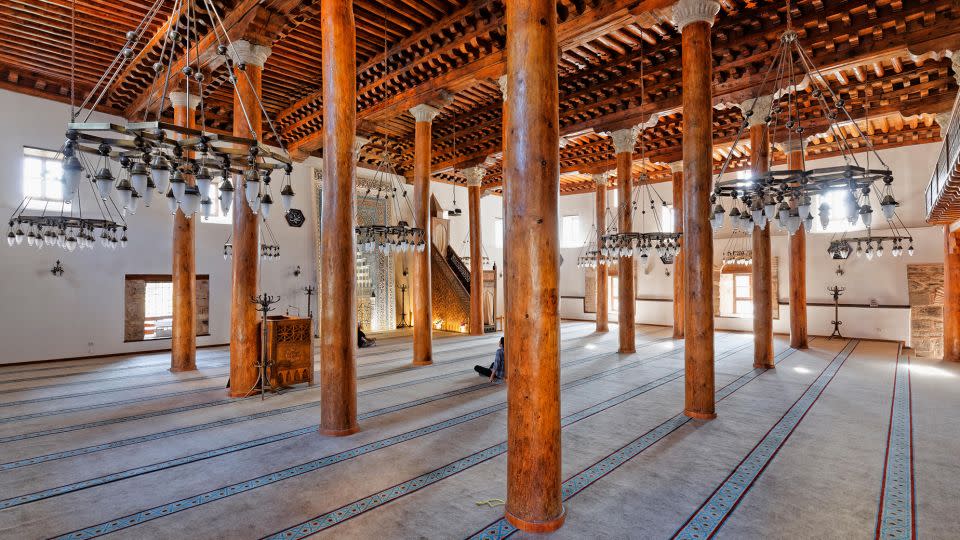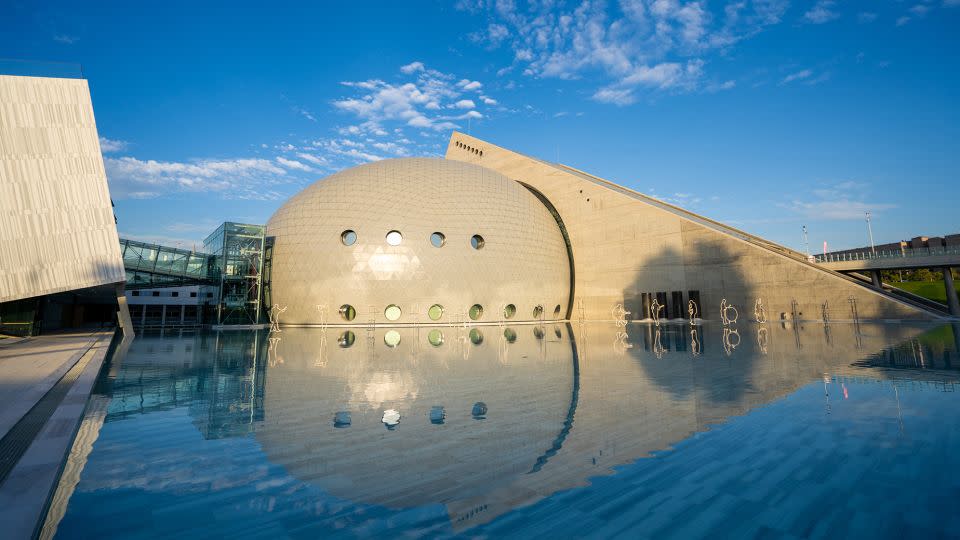Brutalism, bureaucracy and beauty: Why Turkey’s capital city isn’t ‘gray’
Editor’s Note: This CNN Travel series is, or was, sponsored by the country it highlights. CNN retains full editorial control over subject matter, reporting and frequency of the articles and videos within the sponsorship, in compliance with our policy.
Just over a century ago – 1923 to be precise – a crumbling, ancient city in the middle of Turkey found itself catapulted into international prominence as the world around it reeled from years of conflict.
While Istanbul, formerly known as Constantinople, had long been the country’s seat of power, the collapse of the Ottoman empire led to the dawn of a new era for Turkey and that meant a new capital.
Ankara.
Located in the center of the country, Ankara dates back well before Roman times, but as the heart of the newly established Turkish Republic it was soon to become the country’s city of the future.
That meant a radical building plan and equally radical expansion as the city grew into an industrial and administrative powerhouse that is now home to more than 5 million people.
Today, in tourism terms at least, Ankara still lives in the shadow of Istanbul – often unfairly dismissed as a gray, bureaucratic and boring destination.
In reality, it’s a fascinating city. Ankara is quieter, greener, more organized, more livable – a confluence of its history and the youthful energy of its large student population. It’s a city with its own colorful identity,
Ankara’s big leap into bold modernity came when a new city plan was created in 1932 by German architect and urban planner Hermann Jansen.
The city was given a majestic central boulevard, Atatürk Bulvarı – named after Turkish Republic founder Mustafa Kemal Atatürk – and soon European and US-influenced structures began to sprout along it, as well as brand-new cafes and restaurants in the same modern styles.
In 1948, the Ankara State Opera and Ballet was inaugurated, reflecting the new country’s beliefs that the arts were the ultimate representation of modernity.
Originally built in 1933 as an exhibition hall, it was turned into a performing space by German architect Paul Bonatz. The large, curving structure with an elegant columned interior continues to host opera, ballets and concerts.
The building work continued. Vital government structures like the astoundingly imposing Turkish Grand National Assembly, Ministry of Defense and Çankaya Mansion (the official residence of the vice president), among others, were designed by the Austrian architect Clemens Holzmeister.
And, between 1961 and 1980, the city obtained one of its most important university campuses, the Middle East Technical University, one of Turkey’s key works of Brutalist architecture - the modernist style that uses exposed concrete or brick - designed by Behruz and Altuğ Çinici.
Nowadays, the remnants of this nation-building project can still be felt in the architecture of Ankara, its masterplan, its museums, universities and art centers.
And it has continued to grow, cementing its own identity far away from the glamour of Istanbul.
Hidden treasures

One of Ankara’s most important and well-known sites is Anıtkabir, the imposing marble and travertine mausoleum of Atatürk.
But the city’s most-visited quarter is around Ankara Castle, the seventh-century fortification perched on a hill overlooking the Kale neighborhood’s colorful Ottoman-era houses.
Here, the Museum of Anatolian Civilizations contains collections of artefacts from important archeological sites of the surrounding Anatolia region.
Next door, the newly established Erimtan Archaeology and Arts Museum has three beautifully renovated historic Ankara houses that exhibit 2,000 works from the Roman, Urartu, Hittite and Byzantine ages.
Just a few steps away, Divan Çukurhan – an elegant hotel inside a lovingly restored 16th-century caravanserai - is the place for visitors to take a Turkish coffee and dessert break while lounging on leather sofas in the building’s main arcade.
Outside, the many descending cobblestoned streets of Ankara’s historic Samanpazarı quarter are filled with ateliers and shops selling crafts and antiques. An abundance of handmade goods can be found on display outside every vendor, as well as historic caravanserais with artisan shops such as the Tarihi Pilavoğlu Han Çarşısı.
A hidden highlight among the antique and artisan shops here is the Aslanhane Cami, one of Ankara’s oldest mosques, which was recently included in the UNESCO List of Wooden Hypostyle Mosques of Medieval Anatolia. The mosque’s most important element is the ornate wood carving found on the ceiling, mihrab and minbar, a minute weave of floral and geometric patterns.
Ancient wonders

The Ankara Ethnography Museum, the new republic’s first museum built between 1925-1928 by Turkish architect Arif Hikmet Koyunoğlu, exudes a style heavily influenced by the regal Ottoman aesthetic. The exhibition inside includes colorful folk costumes from all over Anatolia, and intricate Ottoman calligraphy and Turkish tile and glass art.
Next door, the Ankara Painting and Sculpture Museum is another thing of exceptional beauty. It was built between 1927-1930, also by Koyunoğlu, in the same regal style of towering and ornamental marble details. Inside, beneath antique chandeliers and ornate ceilings, more than 150 years of Turkish art is on display.
About a 20-minute walk away, and past the city’s Gençlik Parkı, the façade of the İş Bankası İktisadi Bağımsızlık Müzesi (İşbank Economic Independence Museum) is impossible to overlook. The four-story building, with its lancet arches and floral ornaments, was designed by Italian architect Guilio Mongeri in 1929 and includes an oval stained-glass ceiling in the main hall depicting mythological deity Hermes.
The city’s main hub for contemporary art is Cer Modern, founded in 2010 inside a former railway workshop (“Cer” refers to a locomotive train). Hosting exhibitions both inside the vast halls and outside in its art garden, the gallery also organizes workshops and film screenings and has its own café.
Turkey’s Washington

With so much imposing architecture and, let’s face it, bureaucracy, it’s little wonder that Ankara has something of a monochrome reputation in the wider world.
But those who know it well say it’s misunderstood.
Ragip Soylu, a journalist who moved from Washington to Ankara in 2019, has been charting his affection for the city’s visual splendors on Instagram since 2020 via the account Ankara Gri Değil (Ankara is not Gray).
“People usually go to Ankara for bureaucratic affairs whether it’s an exam, visa application or a job related to the judiciary… and so they end up seeing the city from this gray perspective,” says Soylu, the Ankara bureau chief for the Middle East Eye news website.
“For me what makes Ankara special is that it’s an orderly and more peaceful place with less traffic, less crowds, lower inflation than other big cities… While it has become impossible to live in Istanbul, it is quite possible in Ankara. In every sense,” he says.
“There are many places I like in Ankara. Watching the exhibitions and talks at Ka Atölye; discovering the architectural and cultural heritage in different parts of the city with Urban Walks Ankara; listening to a classical music concert at CSO Ada; having breakfast at Kakule Fırın and Sarnii; eating pizza at Mozz Pizza; and enjoying döner kebab from a female chef at Kebapçı Canbolat.”
Soylu, who often compares Ankara to Washington, also recommends discovering the historic Ankara houses of the Hamamönü neighborhood, the new third-wave coffee shops in Bahçelievler, and enjoying the view from Atakule, a notable tower belonging to the city’s first modern mall, originally built in 1989.
Escape to Eskişehir

There are sights to enjoy nearby too.
Thanks to the high-speed Turkish Railways train system, the ride to the nearby university town of Eskişehir has become one of the most popular weekend getaways for Ankara residents.
Touted as one of Turkey’s most European towns, Eskişehir is also famous for the Odunpazarı Historical Urban Site, an open-air museum, which showcases some of the best-preserved examples of traditional Turkish architecture.
The site is also home to the Atlıhan Crafts Bazaar, where the production, display and sale of traditional handicrafts are preserved as well as the world’s only meerschaum (sepiolite) museum – known as lületaşı in Turkish.
Since 2019, Eskişehir has also become a prime destination to visit the OMM (Odunpazarı Modern Museum) designed by the internationally acclaimed Japanese architecture firm Kengo Kuma and Associates.
Housing the modern art collection of architect and contractor Erol Tabanca, the impressive structure composed of stacked and interlocking timber beams is one of the country’s most imposing modern museums.
Right next door, the OMM Inn is a modern boutique hotel inside a renovated Ottoman-era Odunpazarı house with its own café and restaurant – featuring an innovative menu free of any animal products – as well as a shop selling eco-friendly and sustainable goods.
Feride Yalav-Heckeroth is a freelance writer based between Istanbul and Lake Constance and the author of her own guidebook, The 500 Hidden Secrets of Istanbul. Her writing has been published in Kinfolk, Brownbook, The Travel Almanac, Wallpaper*, Travel + Leisure and Conde Nast Traveler.
For more CNN news and newsletters create an account at CNN.com


